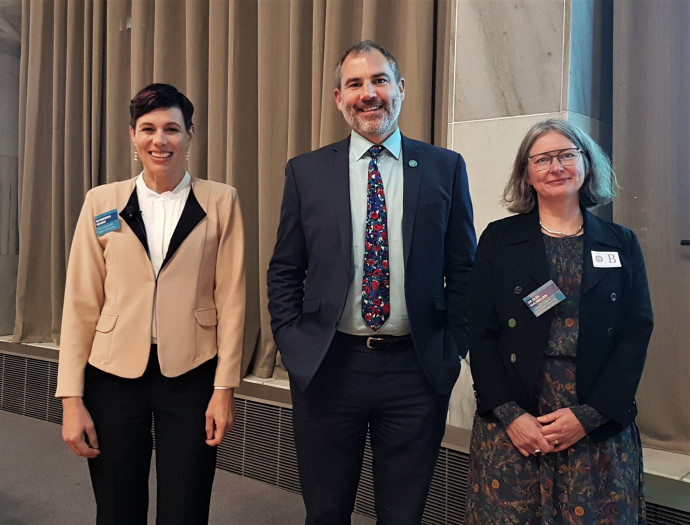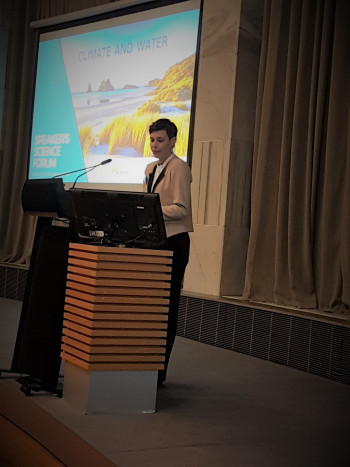Climate change and water

The second event in our Speaker’s Science Forum series for 2023 was held on 10 Haratau May at Parliament. Our speakers discussed the risks of climate change in Aotearoa and how it is affecting our groundwater and health.
Groundwater and climate change in Aotearoa New Zealand: how to preserve our resources and develop our resilience
Frederika (Frédérique) Mourot, Senior Groundwater Scientist, GNS Science
Last year the United Nations released its annual World Water Development report, with for the first time, a main focus on groundwater to make this invisible resource more visible. This report points to the importance of groundwater but also to the fact that this resource is often poorly understood and consequently undervalued, mismanaged and even abused.
In Aotearoa New Zealand, groundwater also plays a crucial role in sustaining environmental health, in providing drinking water to 40% of the population and in generating two billion dollars per year from irrigation to the economy. Groundwater is also more resilient than surface water to hydrological changes. For instance, aquifers can store water during high rainfall events and release water during drier periods. Their location underground limits evaporative losses and help protect their water quality. The significant role of groundwater will also increase with growing pressures from climate change and population growth in the future.
 Climate change and shifts in regional rainfall and temperature are projected to alter the amount of water that will recharge NZ aquifers, with:
Climate change and shifts in regional rainfall and temperature are projected to alter the amount of water that will recharge NZ aquifers, with:
- increased recharge and rises in groundwater levels in some (often already wet) areas (e.g., West and South Otago)
- reduced recharge and drops in groundwater levels in some (often already dry) areas (e.g., in Central Otago)
Rising seas associated with the melting of ice sheets also impact coastal aquifers, with increasing risks of saltwater intrusion and groundwater inundations worldwide. In Aotearoa, most of the large aquifers and large cities are located in coastal plains and therefore under growing threats. Several national studies (e.g., NZ Sea Rise, Future Coasts Aotearoa, Our Changing Coast Programmes) are currently investigating these threats.
Groundwater can support a resilient Aotearoa but a number of actions need to be implemented without delay, including:
- Development of regulations and policies more inclusive of groundwater to allow a better management and protection of our freshwater resources. Without rapidly implementing more efficient protection measures, NZ aquifers will not thrive to support rivers, lakes, aquatic life and communities under a changing climate in the future. For this purpose, groundwater interactions with the land, surface water bodies and the infrastructure also need to be encompassed more systematically in integrated regulations and policies.
- Increased communication, outreach and education to raise the awareness and the recognition of groundwater and help ‘make the invisible visible’.
Further investment to enable an enhanced understanding of NZ aquifers and help fill critical knowledge gaps. This would also facilitate a more integrative groundwater science to maximize the impacts for the environment, iwi and the communities.
Multi-solving responses to accelerating health risks
Dr Alex Macmillan, Associate Professor in Environmental Health at Te Whare Wānanga o Ōtākau
A hotter, wetter, stormier planet is bad news for health and health equity. Globally, climate change is already one of the biggest threats to public health, especially for the lowest income countries, and people within countries whose health is already most affected by systemic injustices, especially people with the lowest incomes, and Indigenous Peoples.
Cyclone Gabrielle starkly demonstrates climate change’s negative effects on health and health equity in Aotearoa, especially via effects on water. This includes the immediate deaths, injuries and traumatic effects of on mental health, loss of homes, clean drinking water and sanitation, and spikes in diseases like leptospirosis and salmonella. Longer term effects are already becoming apparent from the loss of the building blocks of health: safe, dry homes; livelihoods; and access to affordable healthy food. Disruptions to food and housing have ripple effects across the whole country.

In both cities and in rural places, it’s also clear that climate change is coupling with existing faulty dominant land governance and relationships with water to worsen climate health outcomes.
On the other hand, exciting opportunities already exist for responding to these health threats by making each dollar we spend on responding to climate disasters also do work to reduce our emissions, and achieve tangible benefits for people’s health and quality of life. Reaping these benefits requires changing our thinking and governance of land and water towards restoration. We already have some examples of how te Tiriti-centred processes to land use are beneficial for everyone, and are cost effective because of the way they multi-solve for climate, health and fairness. Learning from these processes can guide policy and investment, but not without dealing with corporate obstruction of life-saving climate policy.
